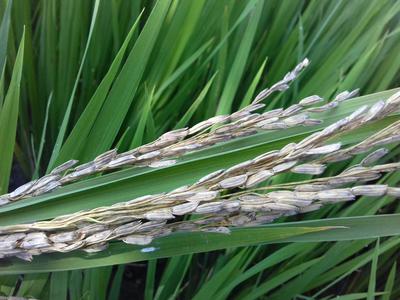Kernel Smut of Rice
Tilletia barclayana
Fungus
In a Nutshell
- Symptoms usually observed at crop maturity.
- Black pustules on grains.
- Black dusty coating on other plant parts.
- The disease reduces grain quality by producing black spores in the place of grain endosperms.
- Some strains of this disease produce toxins.
Can also be found in
Symptoms
The symptoms are most evident when rice reaches its maturity stage. The glumes become dark colored when infected and black pustules break through the hulls. The spores are most noticeable in the early morning when the conditions are dewy. Infected kernels can be partially or completely smutted. Black pustules of spores push through the glumes, which may swell from the moisture of overnight dew. The spores shed from infected grain settle on other plant parts, forming a characteristic black covering that aids in the detection of the disease.
Recommendations

Organic Control
Best biosecurity actions should be put in place to prevent entry, establishment, and spread of the pests and disease. Bioagents like Bacillus Pumilus is very effective against the fungus of Tilletia barclayana.

Chemical Control
Always consider an integrated approach with preventive measures together with biological treatments, if available. The disease is favored by high nitrogen rates, hence apply only the recommended dosage of nitrogen at an appropriate time. Apply Propiconazole containing fungi at the boot growth stage to minimize the amount of infection. Fungicides such as Azoxystrobin, Trifloxystrobin can also be applied.
What caused it?
The disease is caused by the fungus Tilletia barclayana, which is also known as Neovossia horrida. The fungus survives as black spores by replacing the rice kernel. They can be borne by winds and re-infect rice panicles both within a crop and its neighboring crops. The disease spreads when spores of the fungus are transported on infected and contaminated grain, machinery and equipment. Spores of kernel smut of rice are also able to float on water and maybe spread this way. The spores can survive for at least 3 years on grains and even survive the passage through the digestive tract of animals. The fungal development is favored by high temperatures and humidity. In dewy early mornings, smutted grains will swell and burst thereby releasing more spores.
Preventive Measures
- Use less-susceptible cultivars in fields, for example, short and medium grain varieties with no Kernel Smut history.
- Plant certified rice seed earlier.
- Use only the recommended rate of Nitrogen fertilizer.
- Avoid excess Nitrogen rates, especially pre-flood timing.
- Implement good hygiene management to avoid the spread of the disease.
- A quarantine area of 50 m square around the infected rice plant may be recommended.
- Eradicate the infected plants and the surrounding area by burning it.



